Determining the Hydrological Behaviour of Catchment Based on Quantitative Morphometric Analysis in the Hard Rock Area of Nand Samand Catchment, Rajasthan, India
Abstract
:1. Introduction
2. Materials and Methods
2.1. Study area Description
2.2. Data Sources and Analysis
2.3. Quantitative Analysis
3. Results
4. Discussions
5. Conclusions
Author Contributions
Funding
Data Availability Statement
Acknowledgments
Conflicts of Interest
References
- Thakur, J.K.; Thakur, R.K.; Ramanathan, A.; Kumar, M.; Singh, S.K. Arsenic Contamination of Groundwater in Nepal—An Overview. Water 2011, 3, 1. [Google Scholar] [CrossRef]
- Singh, P.; Thakur, J.K.; Kumar, S.; Singh, U.C. Assessment of land use/land cover using Geospatial Techniques in a semi arid region of Madhya Pradesh, India. In Geospatial Techniques for Managing Environmental Resources; Thakur, J.K., Singh, S.K., Ramanathan, A.L., Prasad, M.B.K., Gossel, W., Eds.; Springer and Capital Publication: Heidelberg, Germany, 2011; pp. 152–163. [Google Scholar]
- Diwakar, J.; Thakur, J.K. Environmental system analysis for river pollution control. Water Air Soil Pollut. 2012, 223, 3207–3218. [Google Scholar] [CrossRef]
- F.A.O. Trees, Forests and Land Use in Drylands: The First Global Assessment; FAO: Rome, Italy,, 2019. [Google Scholar]
- Singh, P.; Thakur, J.K.; Singh, U.C. Morphometric analysis of Morar River Basin, Madhya Pradesh, India, using remote sensing and G.I.S. techniques. Environ. Earth Sci. 2013, 68, 1967–1977. [Google Scholar] [CrossRef]
- Tignath, S.; Kapoor, M.; Jha, M.; Sharma, S.K. Morphometric analysis of part of the Hiran River, District Jabalpur, M.P., India using Remote sensing and G.I.S. Int. J. Environ. Sci. 2014, 5, 181–196. [Google Scholar] [CrossRef]
- Bhat, S.A.; Romshoo, S.A. Digital elevation model based watershed characteristics of upper watersheds of Jhelum basin. J. Appl. Hydrol. 2009, 21, 23–34. [Google Scholar]
- Horton, R.E. Erosion development in stream and their drainage basins. Geol. Soc. Am. Bull. 1945, 56, 275–370. [Google Scholar] [CrossRef] [Green Version]
- Smith, K.G. Standards for grading texture of erosional topography. Am. J. Sci. 1950, 248, 655–668. [Google Scholar] [CrossRef]
- Strahler, A.N. Mtm quantitative analysis of watershed Geomorphology. Trans. Am. Geophys. Union 1957, 38, 913–920. [Google Scholar] [CrossRef] [Green Version]
- Thakkar, A.K.; Dhiman, S.D. Morphometric analysis and prioritisation of miniwatersheds in a Mohr watershed, Gujarat using remote sensing and G.I.S. techniques. J. Indian Soc. Remote Sens. 2007, 35, 313–321. [Google Scholar] [CrossRef]
- Hlaing, K.; Haruyama, S.; Maung, A. Using GIS-based distributed soil loss modeling and morphometric analysis to prioritise watershed for soil conservation in Bago river basin of Lower Myanmar. Front. Earth Sci. China 2008, 2, 465–478. [Google Scholar] [CrossRef]
- Sreedevi, P.D.; Owais, S.; Khan, H.H.; Ahmed, S. Morphometric analysis of a watershed of south India using SRTM data and G.I.S. J. Geol. Soc. India 2009, 73, 543–552. [Google Scholar] [CrossRef]
- Patel, D.P.; Dholakia, M.B. Water harvesting structure positioning by using geo-visualisation concept and prioritisation of mini-watersheds through morphometric analysis in the Lower Tapi Basin. J. Indian Soc. Remote Sens. 2011, 40, 299–312. [Google Scholar] [CrossRef]
- Aher, P.D.; Adinarayana, J.; Gorantiwar, S.D. Quantification of morphometric characterisation and prioritisation for management planning in semi-arid tropics of India: A remote sensing and G.I.S. approach. J. Hydrol. 2014, 511, 850–860. [Google Scholar] [CrossRef]
- Albaroot, M.; Al-Areeq, N.M.; Aldharab, H.S.; Alshayef, M.; Ghareb, S.A. Quantification of Morphometric Analysis using Remote Sensing and G.I.S. Techniques in the Qa’ Jahran Basin, Thamar Province, Yemen. Int. J. New Technol. Res. 2018, 4, 12–22. [Google Scholar]
- Singh, N.; Jha, M.; Tignath, S.; Singh, B.N. Morphometric analysis of a badland affected portion of the Mandakini River sub-watershed, central India. Arab. J. Geosci. 2020, 13, 423. [Google Scholar] [CrossRef]
- Shivaswamy, M.; Ravikumar, A.S.; Shivakumar, B.L. Quantitative Morphometric and Hypsometric Analysis Using Remote Sensing and G.I.S. Techniques. Int. J. Adv. Res. Eng. Technol. 2019, 10, 1–14. [Google Scholar] [CrossRef]
- Said, S.; Siddique, R.; Shakeel, M. Morphometric analysis and sub-watersheds prioritisation of Nagmati River watershed, Kutch District, Gujarat using G.I.S. based approach. J. Water Land Dev. 2018, 39, 131–139. [Google Scholar] [CrossRef] [Green Version]
- Mangan, P.; Haq, M.A.; Baral, P. Morphometric analysis of watershed using remote sensing and G.I.S.—A case study of Nanganji River Basin in Tamil Nadu, India. Arab. J. Geosci. 2019, 12, 202. [Google Scholar] [CrossRef]
- Kumari, P.; Kumari, R.; Kumar, D. Geospatial approach to evaluate the morphometry of Sabarmati River Basin, India. Arab. J. Geosci. 2021, 14, 206. [Google Scholar] [CrossRef]
- Obeidat, M.; Awawdeh, M.; Al-Hantouli, F. Morphometric analysis and prioritisation of watersheds for flood risk management in Wadi Easal Basin (W.E.B.), Jordan, using geospatial technologies. J. Flood Risk Manag. 2021, 14, e12711. [Google Scholar] [CrossRef]
- Arulbalaji, P.; Padmalal, D. Sub-watershed Prioritization Based on Drainage Morphometric Analysis: A Case Study of Cauvery River Basin in South India. J. Geol. Soc. India 2020, 95, 25–35. [Google Scholar] [CrossRef]
- Kasi, V.; Pinninti, R.; Landa, S.R.; Rathinasamy, M.; Sangamreddi, C.; Kuppili, R.R.; Radha, P.R.D. Comparison of different digital elevation models for drainage morphometric parameters: A case study from South India. Arab. J. Geosci. 2020, 13, 1050. [Google Scholar] [CrossRef]
- Bogale, A. Morphometric analysis of a drainage basin using geographical information system in Gilgel Abay watershed, Lake Tana Basin, upper Blue Nile Basin, Ethiopia. Appl. Water Sci. 2021, 11, 122. [Google Scholar] [CrossRef]
- Giri, P.; Diwate, P.; Mawale, Y.K. Chapter 4. Morphometric Analysis of Tapi Drainage Basin Using Remote Sensing and GIS Techniques. Sustain. Dev. Pract. Using Geoinform. 2020, 57–72. [Google Scholar] [CrossRef]
- Zerouali, B.; Chettih, M.; Alwetaishi, M.; Abda, Z.; Elbeltagi, A.; Augusto Guimarães Santos, C.; Hussein, E.E. Evaluation of Karst Spring Discharge Response Using Time-Scale-Based Methods for a Mediterranean Basin of Northern Algeria. Water 2021, 13, 2946. [Google Scholar] [CrossRef]
- Akanwa, A.O. River Sand Mining and Its Ecological Footprint at Odor River, Nigeria. In Agroecological Footprints Management for Sustainable Food System; Banerjee, A., Meena, R.S., Jhariya, M.K., Yadav, D.K., Eds.; Springer: Singapore, 2021. [Google Scholar]
- Ikhsan, J.; Rezanaldy, A.; Rozainy, M.Z.M.R. Analysis of Sand Mining Impacts on Riverbed in the Downstream of the Progo River, Indonesia. In IOP Conference Series: Materials Science and Engineering; IOP Publishing: Bristol, UK; London, UK, 2021; p. 012065. [Google Scholar]
- Chandrashekar, H.; Lokesh, K.V.; Sameena, M.; Roopa, J.; Ranganna, G. GIS—Based Morphometric Analysis of Two Reservoir Catchments of Arkavati River, Ramanagaram District, Karnataka. In Proceedings of the International Conference on Water Resources, Coastal and Ocean Engineering (ICWRCOE), Mangalore, India, 12–14 March 2015. [Google Scholar]
- Krishnamurthy, J.; Srinivas, G.; Jayaraman, V.; Chandrashekar, M.G. Influence of rock types and structures in the development of drainage networks in typical hard rock terrain. ITC J. 1996, 3–4, 252–259. [Google Scholar]
- CGWB Central Ground Water Board. Ground Water Information Rajsamand District Rajasthan; Government of India Ministry of Water Resources: Jaipur, India, 2013.
- GWDR Ground Water Department Rajasthan. Hydrogeological Atlas of Rajasthan Rasamand District; Rolta India Limited: Mumbai, India, 2013. [Google Scholar]
- Ahmed, S.A.; Chandrashekarappa, K.N.; Raj, S.K.; Nischitha, V.; Kavitha, G. Evaluation of morphometric parameters derived from ASTER and SRTM DEM—A study on Bandihole sub-watershed basin in Karnataka. J. Indian Soc. Remote Sens. 2010, 38, 227–238. [Google Scholar] [CrossRef]
- Günal, A.Y.; Güven, A. Determination of Geomorphological Parameters of Damlica Basin Using GIS. In Proceedings of the International Conference on Computational and Experimental Science and Engineering (ICCESEN 2014), Kemer, Turkey, 25–29 October 2014. [Google Scholar] [CrossRef]
- Ozulu, İ.M.; Gökgöz, T. Examining the Stream Threshold Approaches Used in Hydrologic Analysis. ISPRS Int. J. Geo-Inf. 2018, 7, 201. [Google Scholar] [CrossRef] [Green Version]
- Thomas, J.; Joseph, S.; Thrivikramji, K.P.; Arunkumar, K.S. Sensitivity of digital elevation models: The scenario from two tropical mountain river basins of the Western Ghats, India. Geosci. Front. 2014, 5, 893–909. [Google Scholar] [CrossRef] [Green Version]
- Mark, D.M. Relation between field-surveyed channel network and map-based geomorphometric measures, Inez Kentucky. Ann. Assoc. Am. Geogr. 1983, 73, 358–372. [Google Scholar] [CrossRef]
- Odiji, C.A.; Aderoju, O.M.; Eta, J.B.; Shehu, I.; Mai-Bukar, A.; Onuoha, H. Morphometric analysis and prioritisation of upper Benue River watershed, Northern Nigeria. Appl. Water Sci. 2021, 11, 41. [Google Scholar] [CrossRef]
- Jolly, J.P. A Proposed Method for Accurately Calculating Sediment Yields from Reservoir Deposition Volumes; International Association of Hydrological Sciences: Wallingford, UK, 1982. [Google Scholar]
- Ogunkoya, O.O.; Adejuwon, J.O.; Jeje, L.K. Runoff response to basin parameters in southwestern Nigeria. J. Hydrol. 1984, 72, 67–84. [Google Scholar] [CrossRef]
- Breinlinger, R.; Dister, H.; Weingartner, R. Methods of Catchment Characterisation by Means of Basin Parameters (Assisted by G.I.S.)—Empirical Report from Switzerland; Report No. 120 Methods of hydrological basin comparison; Institute of Hydrology: Wallingford, UK, 1992; pp. 171–181. [Google Scholar]
- Strahler, A.N. Quantitative geomorphology of drainage basins and channel networks. In Handbook of Applied Hydrology; McGraw-Hill: New York, NY, USA, 1964; pp. 4–39. [Google Scholar]
- Kar, G.; Kumar, A.; Singh, R. Spatial distribution of soil hydro-physical properties and morphometric analysis of a rainfed watershed as a tool for sustainable land use planning. Agric. Water Manag. 2009, 96, 1449–1459. [Google Scholar] [CrossRef]
- Rawat, U.; Awasthi, A.; Gupta, D.S.; Paul, R.S.; Tripathi, S. Morphometric Analysis using Remote Sensing and G.I.S. Techniques in the Bagain River Basin, Bundelkhand Region, India. Indian J. Sci. Technol. 2017, 10. [Google Scholar] [CrossRef]
- Pandey, P.K.; Das, S.S. Morphometric analysis of Usri River basin, Chhotanagpur Plateau, India, using remote sensing and GIS. Arab. J. Geosci. 2016, 9, 240. [Google Scholar] [CrossRef]
- Schumm, S.A. Evolution of drainage systems and slopes in badlands at Perth Amboy, New Jersey. Geol. Soc. Am. Bull. 1956, 67, 597–646. [Google Scholar] [CrossRef]
- Horton, R.E. Drainage-basin characteristics. Trans. Am. Geophys. Union 1932, 13, 350–361. [Google Scholar] [CrossRef]
- Veeranna, J.; Gouthami, K.; Yadav, P.B.; Mallikarjuna, V.R. Calculating linear and areal and relief aspect parameters using geospatial techniques (ArcGIS 10. 2 and SWAT model) for for Akkeru River Basin Warangal, Telangana, India. Int. J. Curr. Microbiol. Appl. Sci. 2017, 6, 1803–1809. [Google Scholar] [CrossRef]
- Reddy, G.P.O.; Maji, A.K.; Gajbhiye, K.S. Drainage morphometry and its influence on landform characteristics in a basaltic terrain, Central India—A remote sensing and G.I.S. approach. Int. J. Appl. Earth Obs. Geoinf. 2004, 6, 1–16. [Google Scholar] [CrossRef]
- Subramanya, K. A Book-Engineering Hydrology, 4th ed.; 8th reprint; McGraw Hill Education: Noida, India, 2015; p. 172. [Google Scholar]
- Miller, V.C. Quantitative Geomorphic Study of Drainage Basin Characteristic in the Clinch Mountain Area; Technical Report 3; Department of Geology, Columbia University: New York, NY, USA, 1953. [Google Scholar]
- Suresh, R. A Book-Soil and Water Conservation Engineering, 5th ed.; 2nd reprint; Jain, A.K., Ed.; Standard Publisher Distributors: New Delhi, India, 2014; p. 918. [Google Scholar]
- Schumm, S.A. Sinuosity of alluvial rivers on the Great Plains. Geol. Soc. Am. Bull. 1963, 74, 93–114. [Google Scholar] [CrossRef]
- Melton, M.A. An Analysis of the Relations among Elements of Climate, Surface Properties and Geomorphology; Technical report (United States. Office of Naval Research), no. ONR-11; Columbia University: New York, NY, USA, 1957. [Google Scholar]
- Bera, A.; Mukhopadhyay, B.P.; Das, D. Morphometric analysis of Adula River Basin in Maharashtra, India using G.I.S. and remote sensing techniques. Geogr. Nat. Resour. 2018, 13–35. [Google Scholar] [CrossRef]
- Langbein, W.B. Topographic characteristics of drainage basins. U.S. Geol. Soc. Water-Supply Pap. 1947, 968, 125–158. [Google Scholar]
- Prasannakumar, V.; Vijith, H.; Geetha, N. Terrain evaluation through the assessment of geomorphometric parameters using D.E.M. and G.I.S.: Case study of two major sub-watersheds in Attapady, South India. Arab. J. Geosci. 2013, 6, 1141–1151. [Google Scholar] [CrossRef]
- Gajbhiye, S.; Mishra, S.K.; Pandey, A. Hypsometric analysis of Shakkar River catchment through geographical information system. J. Geol. Soc. India 2014, 84, 192–196. [Google Scholar] [CrossRef]
- Sharma, S.; Mahajan, A.K. GIS-based sub-watershed prioritisation through morphometric analysis in the outer Himalayan region of India. Appl. Water Sci. 2020, 10, 1–11. [Google Scholar] [CrossRef]
- Pike, R.J.; Wilson, S.E. Elevation-relief ratio, hypsometric integral, and geomorphic area-altitude analysis. Geol. Soc. Am. Bull. 1971, 82, 1079–1084. [Google Scholar] [CrossRef]
- Hadley, R.F.; Schumm, S.A. Sediment sources and drainage basin characteristics in upper Cheyenne River basin. U.S. Geol. Surv. Water-Supply Pap. 1961, 1531, 198. [Google Scholar] [CrossRef]
- Mesa, L.M. Morphometric analysis of a subtropical Andean basin (Tucumán, Argentina). Environ. Geol. 2006, 50, 1235–1242. [Google Scholar] [CrossRef]
- Rai, P.K.; Narayan, V.; Mohan, K. Remote sensing applications: Society and environment. A study of morphometric evaluation of the Son basin, India using geospatial approach. Remote Sens. Appl. Soc. Environ. 2017, 7, 9–20. [Google Scholar] [CrossRef]
- Mahala, A. The significance of morphometric analysis to understand the hydrological and morphological characteristics in two different morpho-climatic settings. Appl. Water Sci. 2019, 10, 1–16. [Google Scholar] [CrossRef] [Green Version]
- Chandrasekar, N.; Magesh, N.S. Morphometric analysis of the River Thamirabarani sub-basin in Kanyakumari District, South west coast of Tamil Nadu, India, using remote sensing and G.I.S. Environ. Earth Sci. 2014, 73, 7375–7401. [Google Scholar] [CrossRef]
- Dubey, S.K.; Sharma, D.; Mundetia, N. Morphometric Analysis of the Banas River Basin Using the Geographical Information System, Rajasthan, India. Hydrology 2015, 3, 47–54. [Google Scholar] [CrossRef] [Green Version]
- Sreedevi, P.D.; Subrahmanyam, K.; Ahmed, S. The significance of morphometric analysis for obtaining groundwater potential zones in a structurally controlled terrain. Environ. Geol. 2005, 47, 412–420. [Google Scholar] [CrossRef]
- Kanhaiya, S.; Singh, S.; Singh, C.K.; Srivastava, V.K.; Patra, A. Geomorphic evolution of the Dongar River Basin, Son Valley, Central India. Geol. Ecol. Landsc. 2019, 3, 269–281. [Google Scholar] [CrossRef] [Green Version]
- Pareta, K.; Pareta, U. Quantitative Morphometric Analysis of a Watershed of Yamuna Basin, India using ASTER (D.E.M.) Data and G.I.S. Int. J. Geomat. Geosci. 2011, 2, 248–269. [Google Scholar]
- Ali, S.A.; Alhamed, M.; Ali, U. Morphometric analysis of Abdan Basin, Almahfid basement rock, Yemen: Using remote sensing and GIS. Int. J. Adv. Remote Sens. GIS 2016, 5, 1605–1617. [Google Scholar] [CrossRef] [Green Version]
- Anderson, M.G.; Burt, T.P. The role of topography in controlling throughflow generation. Earth Surf. Process. 1978, 3, 331–344. [Google Scholar] [CrossRef]
- Taha, M.M.N.; Elbarbary, S.M.; Naguib, D.M.; El-Shamy, I.Z. Flash flood hazard zonation based on basin morphometry using remote sensing and G.I.S. techniques: A case study of Wadi Qena basin, Eastern Desert, Egypt. Remote Sens. Appl. Soc. Environ. 2017, 8, 157–167. [Google Scholar] [CrossRef]
- Pande, C.B.; Moharir, K. G.I.S. based quantitative morphometric analysis and its consequences: A case study from Shanur River Basin, Maharashtra India. Appl. Water Sci. 2017, 7, 861–871. [Google Scholar] [CrossRef] [Green Version]
- Prakash, K.; Rawat, D.; Singh, S.; Chaubey, K.; Kanhaiya, S.; Mohanty, T. Morphometric analysis using SRTM and G.I.S. in synergy with depiction: A case study of the Karmanasa River basin, North central India. Appl. Water Sci. 2019, 9, 13. [Google Scholar] [CrossRef] [Green Version]
- Dahiphale, P.; Singh, P.K.; Yadav, K.K. Morphometric Analysis of Sub-Basins in Jaisamand Catchment Using Geographical Information System. Int. J. Eng. Res. Technol. 2014, 2, 189–202. [Google Scholar]
- Sarma, J.N.; Shukla, A.; Murgante, B. Morphotectonic study of the Brahmaputra basin using geoinformatics. J. Geol. Soc. India 2015, 86, 324–330. [Google Scholar] [CrossRef]
- Soni, S. Assessment of morphometric characteristics of Chakrar watershed in Madhya Pradesh India using geospatial technique. Appl. Water Sci. 2016, 7, 2089–2102. [Google Scholar] [CrossRef] [Green Version]
- Samal, D.R.; Gedam, S.S.; Nagarajan, R. G.I.S. based drainage morphometry and its influence on hydrology in parts of Western Ghats region. Geocarto Int. 2015, 30, 755–778. [Google Scholar] [CrossRef]
- Bisht, S.; Chaudhry, S.; Sharma, S.; Soni, S. Assessment of flash flood vulnerability zonation through geospatial technique in high altitude Himalayan watershed, Himachal Pradesh India. Remote Sens. Appl. Soc. Environ. 2018, 12, 35–47. [Google Scholar] [CrossRef]
- Farhan, Y.; Anbar, A.; Enaba, O.; Al-Shaikh, N. Quantitative Analysis of Geomorphometric Parameters of Wadi Kerak, Jordan, Using Remote Sensing and GIS. J. Water Resour. Prot. 2015, 7, 456–475. [Google Scholar] [CrossRef] [Green Version]
- Chottopadhyay, N.; Hasmi, S. The Sung Valley Alkaline Ultramafic Carbonalite Complex, East Khasi Hills and Jaintia Hills district, Meghalaya. GSI Rec. 1984, 113, 24–33. [Google Scholar]
- Ritter, J.; Berenguer, M.; Corral, C.; Park, S.; Sempere-Torres, D. ReAFFIRM: Real-time assessment of flash flood impacts–a regional high-resolution method. Environ. Int. 2020, 136, 105375. [Google Scholar] [CrossRef]
- John Wilson, J.S.; Chandrasekar, N.; Magesh, N.S. Morphometric analysis of major sub-watersheds in Aiyar and Karai Pottanar Basin, central Tamil Nadu, India usingremote sensing and GIS techniques. Bonfring Int. J. Ind. Eng. Manag. Sci. 2012, 2, 8–15. [Google Scholar]
- Awasthi, K.D.; Situla, B.K.; Singh, B.R.; Bajacharaya, R.M. Land-use changes in two Nepalese watersheds: GIS and geomorphometric analysis. Land Degrad. Dev. 2002, 13, 495–513. [Google Scholar] [CrossRef]
- Bishop, M.P.; Shroder, J.F.; Bonk, R.; Olsenholler, J. Geomorphic change in high mountains: A western Himalayan perspective. Glob. Planet. Change 2002, 32, 311–329. [Google Scholar]
- Agarwal, C.S. Study of drainage pattern through aerial data in Naugarh area of Varanasi district, U.P. J. Indian Soc. Remote Sens. 1998, 26, 169–175. [Google Scholar] [CrossRef]
- Rudraiah, M.; Govindaiah, S.; Srinivas Vittala, S. Morphometry using Remote Sensing and GIS Techniques in the Sub-Basins of Kagna River Basin, Gulburga District, Karnataka, India. J. Indian Soc. Remote Sens. 2008, 36, 351–360. [Google Scholar] [CrossRef]
- Mayilvaganan, M.K.; Mohana, P.; Naidu, K.B. Delineating groundwater potential zones in Thurinjapuram watershed using geospatial techniques. Indian J. Sci. Technol. 2011, 4, 1470–1476. [Google Scholar] [CrossRef]
- Sen Gupta, D.; Dwivedi, L.; Tripathi, S.K.; Ghosh, P.; Awasthi, A. Groundwater potential mapping of Sihu river watershed area of Mahoba district, U.P. using remote sensing and GIS. Int. J. Appl. Res. 2015, 1, 241–248. [Google Scholar]
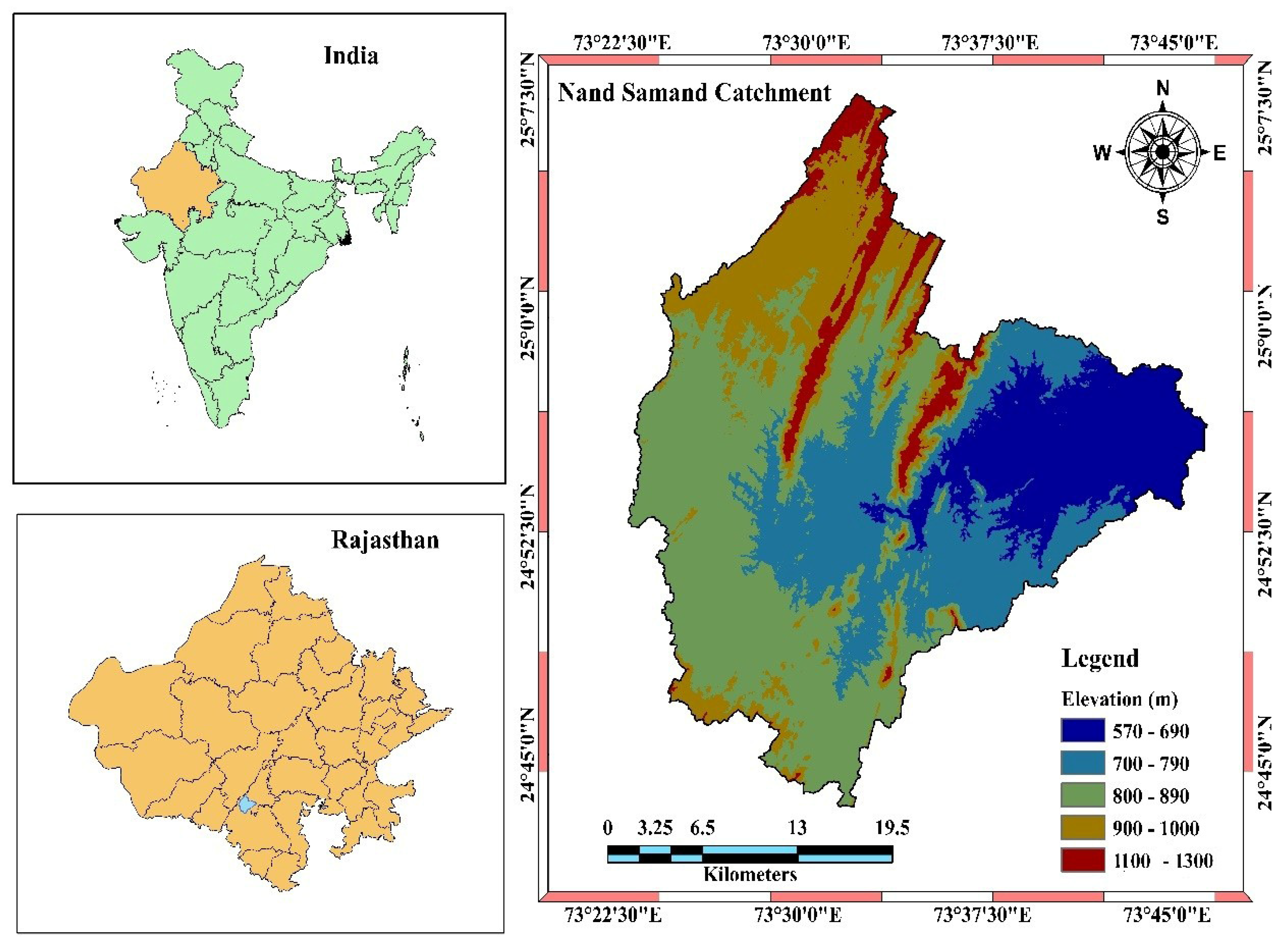
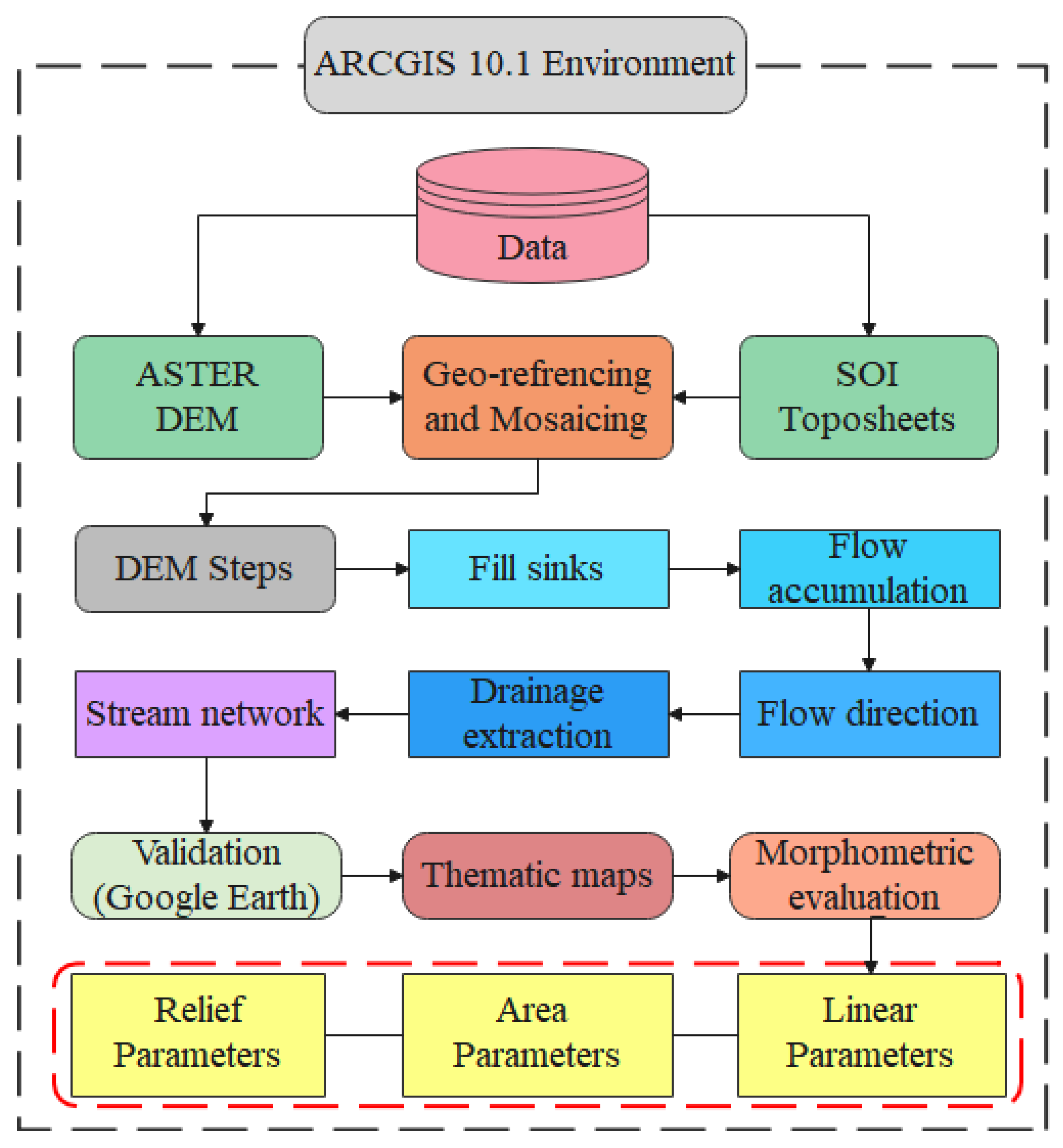

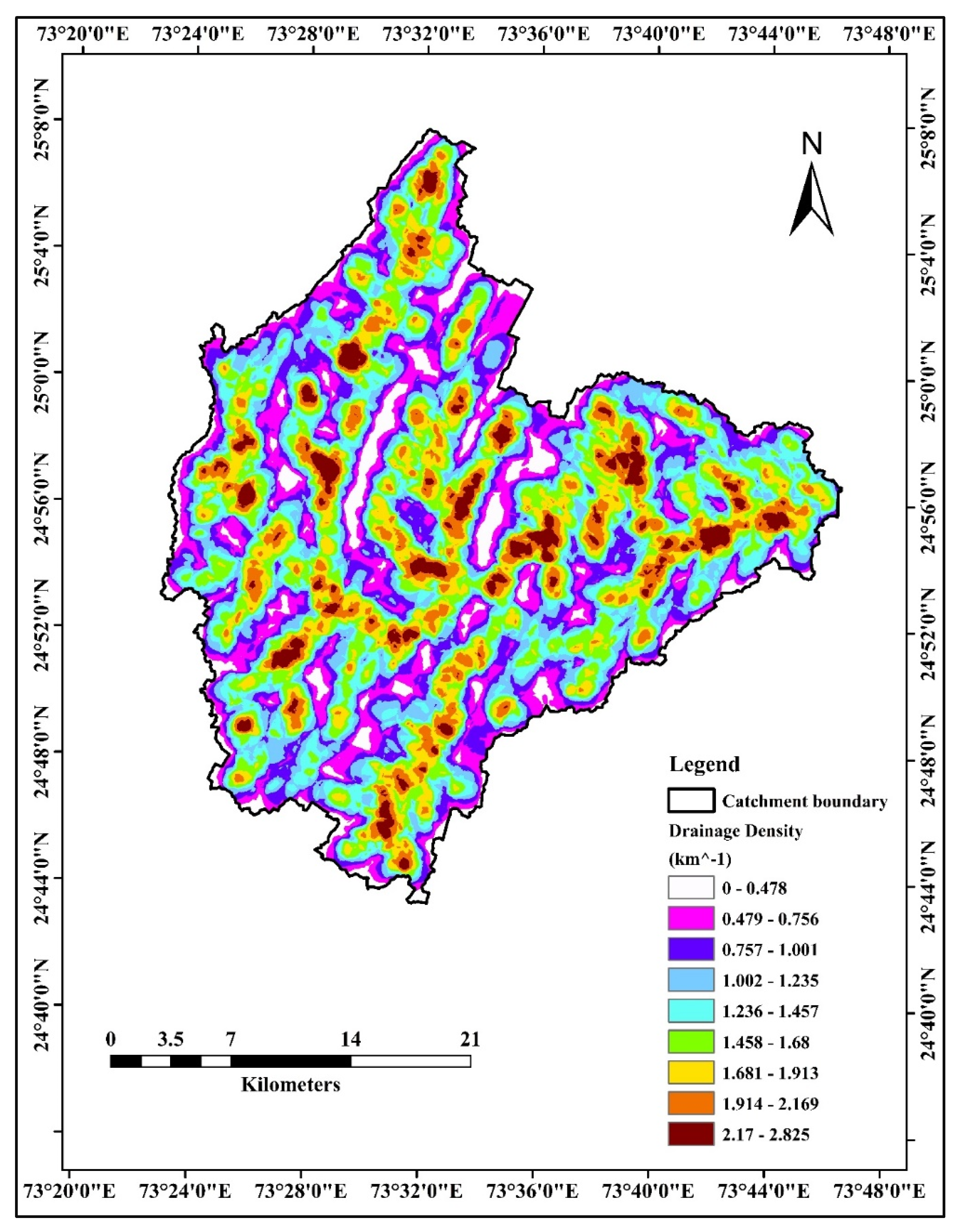
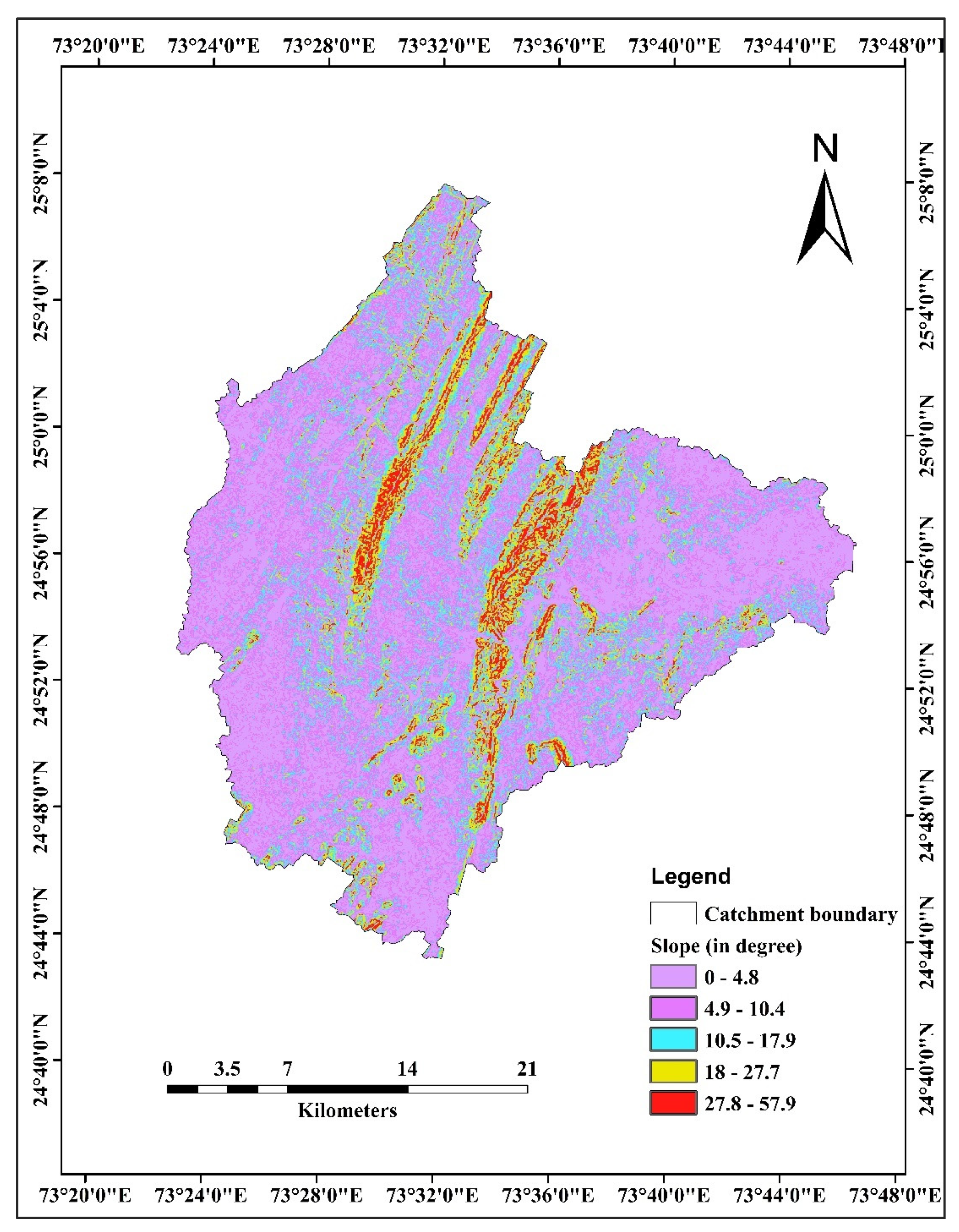
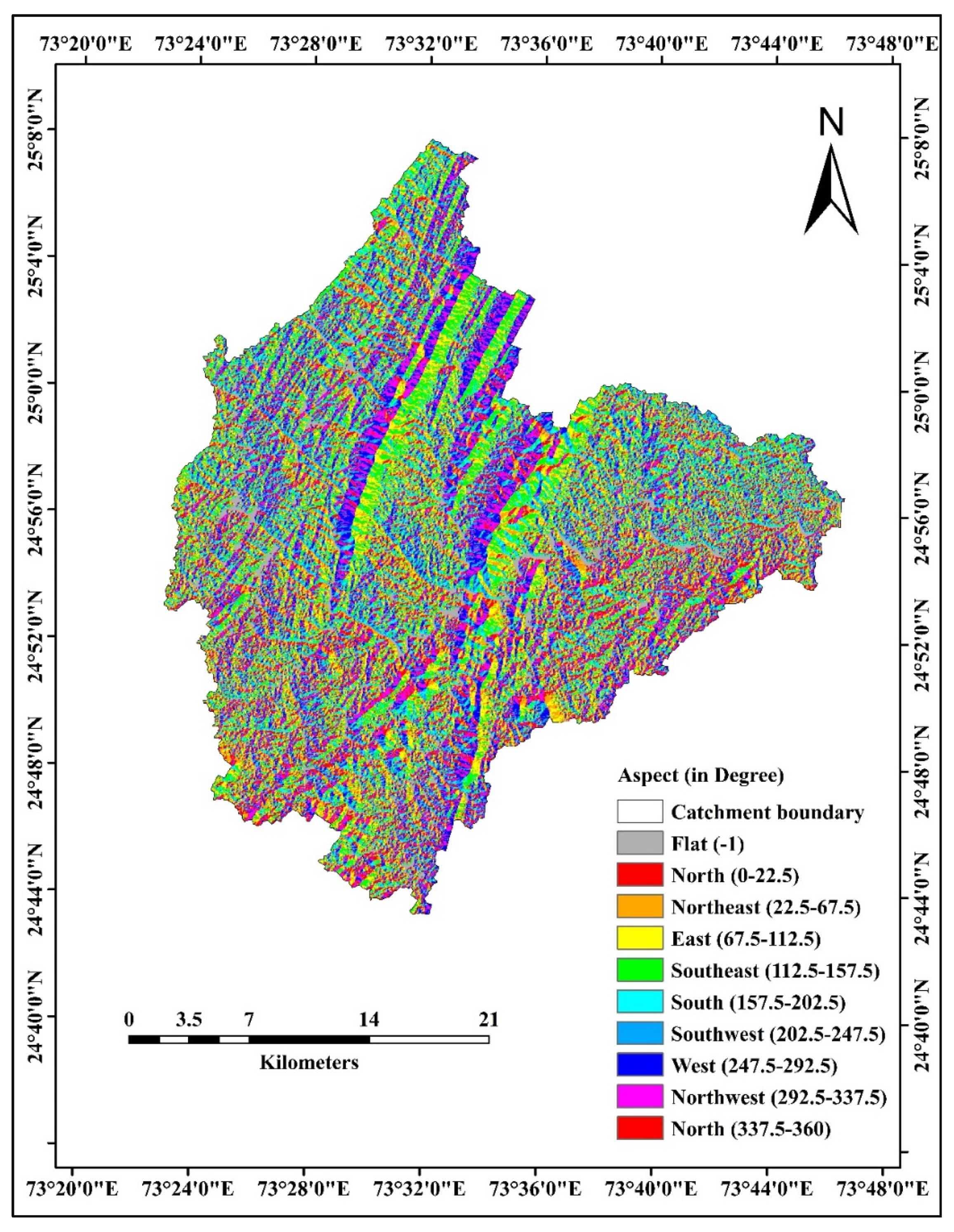

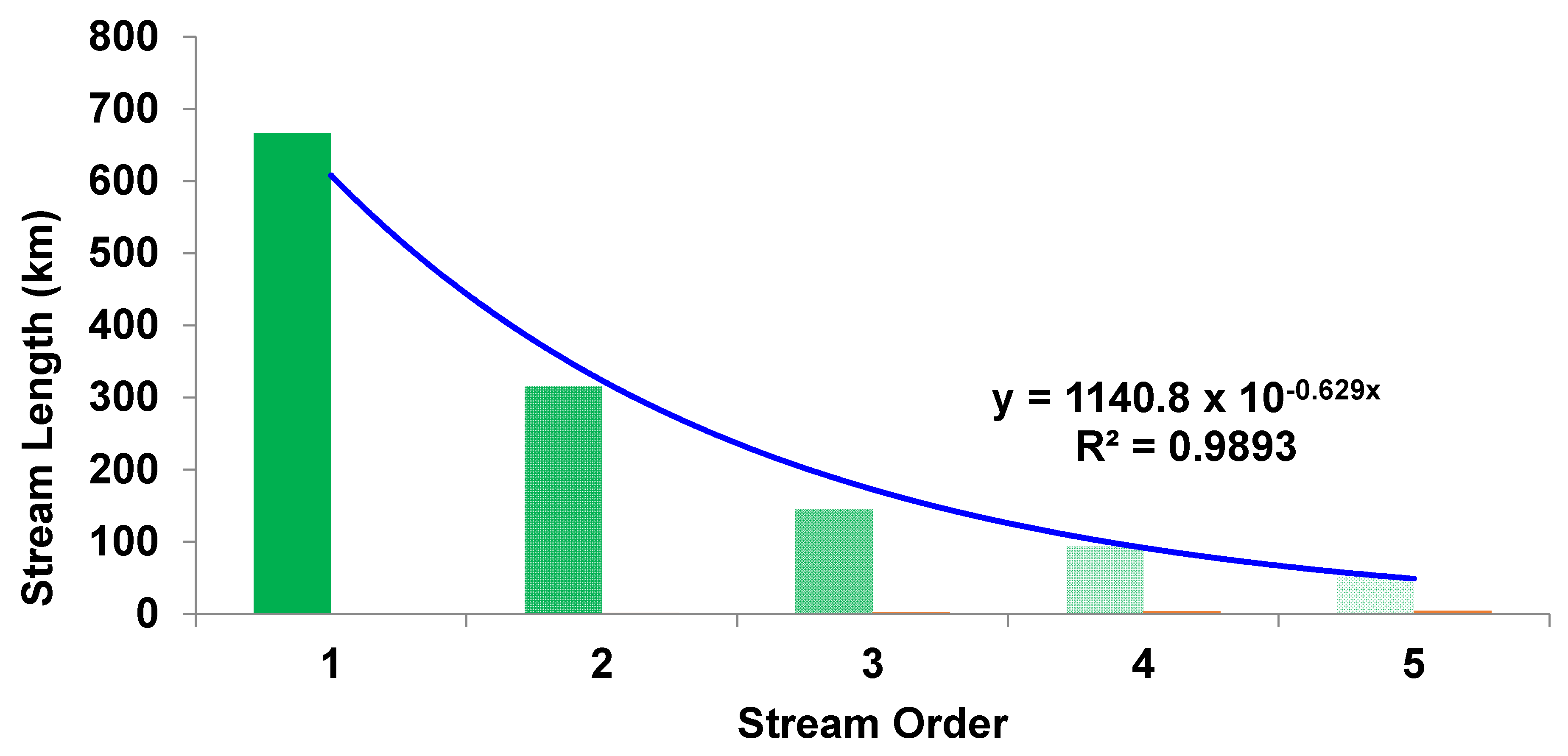
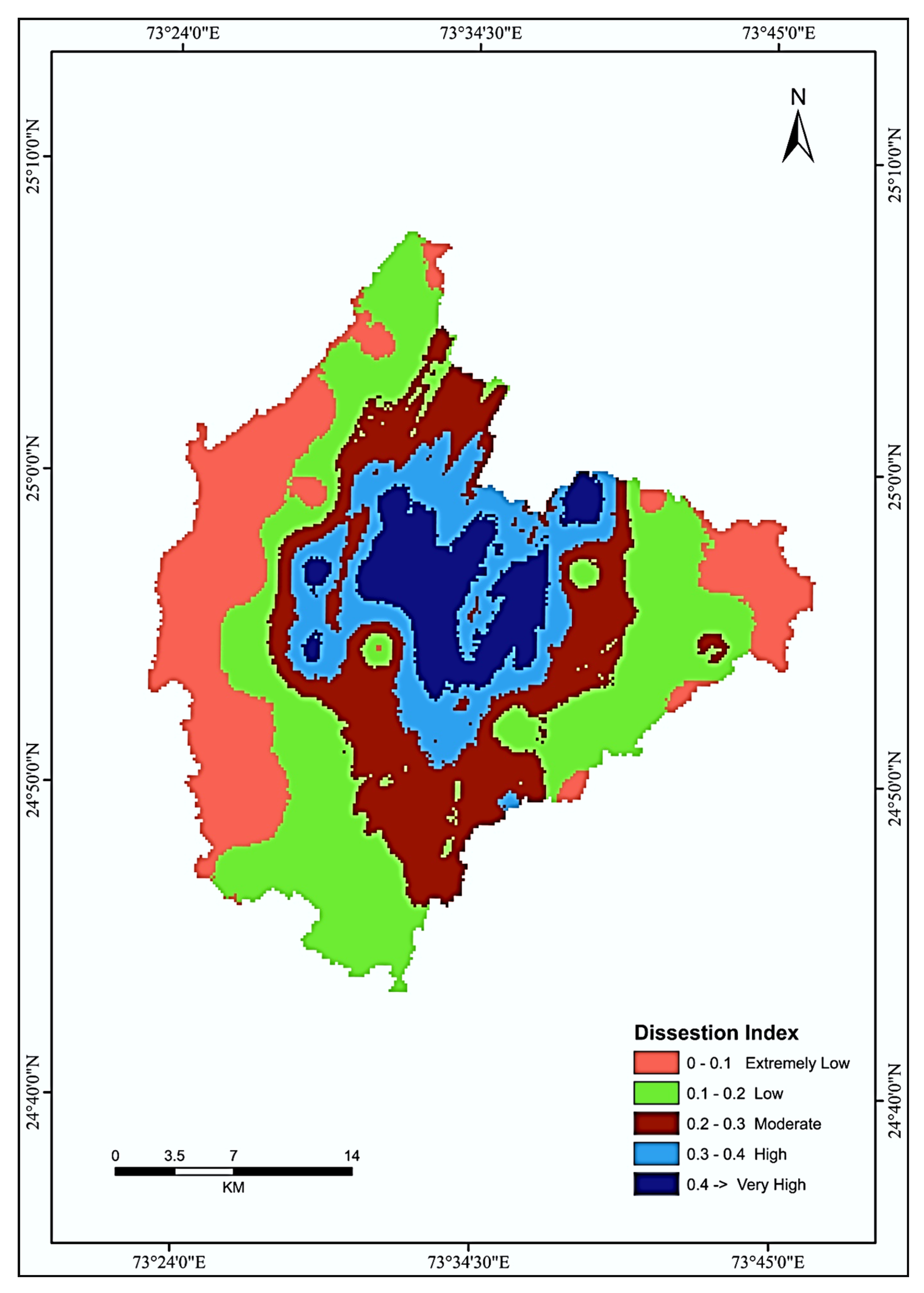
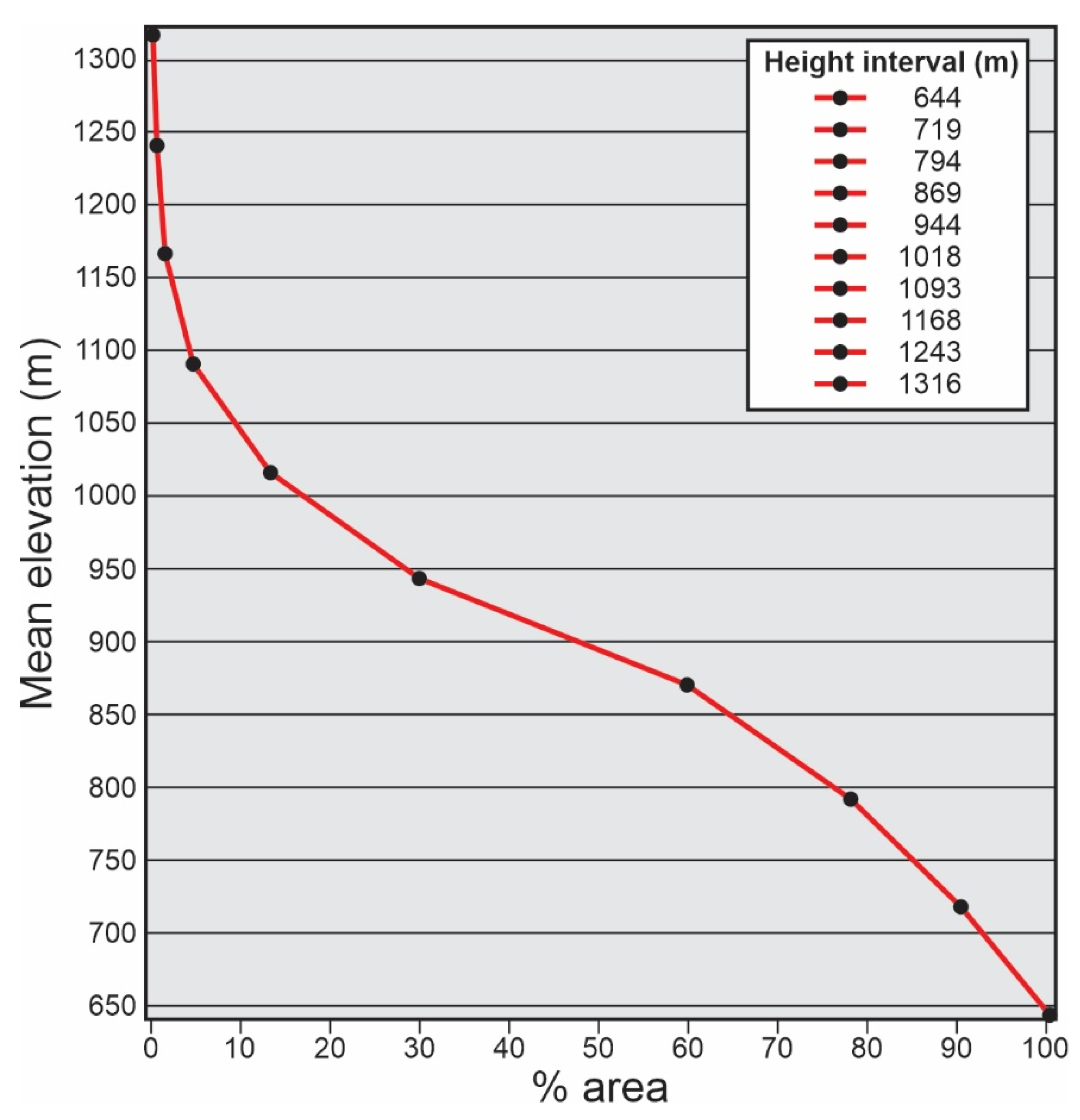
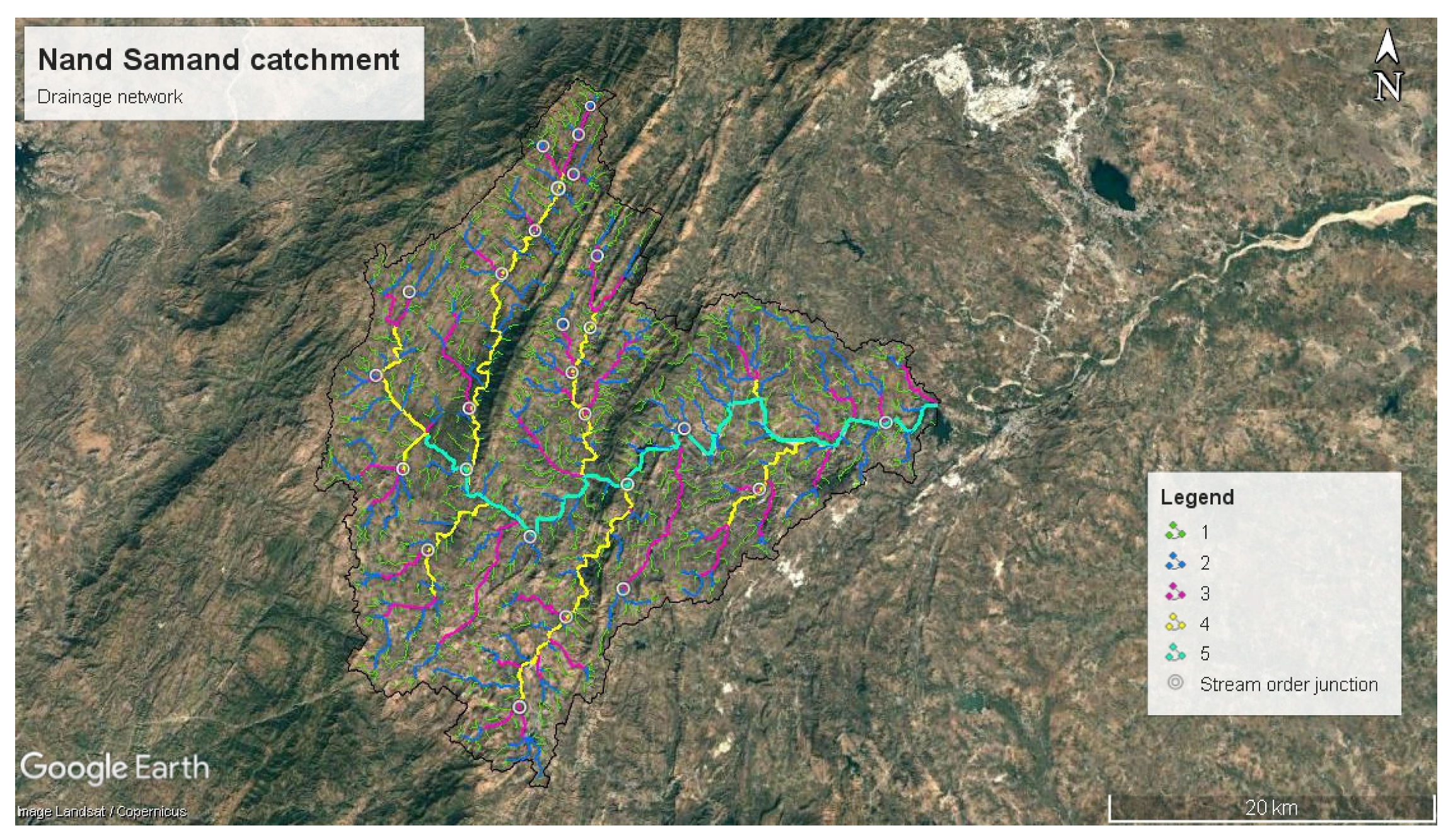
| 1 | 922 | 666.89 | 0.46 | 0.72 | 2.18 | 0 |
| 2 | 422 | 316.56 | 0.54 | 0.75 | 1.85 | 0 |
| 3 | 228 | 145.91 | 0.72 | 0.64 | 1.39 | 0 |
| 4 | 164 | 95.42 | 0.54 | 0.58 | 1.86 | 0 |
| 5 | 88 | 52.21 | - | 0.59 | - | 0 |
| Total | 1824 | 1276.99 | 7.29 | 1.82 |
| (A) () | ) | (C) | ) | (L) (km) | |||||||
|---|---|---|---|---|---|---|---|---|---|---|---|
| 865.18 | 197.38 | 1.48 | 2.11 | 6.47 | 3.11 | 0.68 | 0.34 | 82.66 | 0.13 | 0.28 | 0.40 |
| Maximum Height of the Catchment (Z) (m) | Minimum Height of the Catchment (z) (m) | Catchment Relief (H) (m) | Relief Ratio | Relative Relief | Ruggedness Number |
|---|---|---|---|---|---|
| 1318 | 570 | 748 | 0.01 | 0.38 | 1.10 |
Publisher’s Note: MDPI stays neutral with regard to jurisdictional claims in published maps and institutional affiliations. |
© 2022 by the authors. Licensee MDPI, Basel, Switzerland. This article is an open access article distributed under the terms and conditions of the Creative Commons Attribution (CC BY) license (https://creativecommons.org/licenses/by/4.0/).
Share and Cite
Dimple, D.; Rajput, J.; Al-Ansari, N.; Elbeltagi, A.; Zerouali, B.; Santos, C.A.G. Determining the Hydrological Behaviour of Catchment Based on Quantitative Morphometric Analysis in the Hard Rock Area of Nand Samand Catchment, Rajasthan, India. Hydrology 2022, 9, 31. https://doi.org/10.3390/hydrology9020031
Dimple D, Rajput J, Al-Ansari N, Elbeltagi A, Zerouali B, Santos CAG. Determining the Hydrological Behaviour of Catchment Based on Quantitative Morphometric Analysis in the Hard Rock Area of Nand Samand Catchment, Rajasthan, India. Hydrology. 2022; 9(2):31. https://doi.org/10.3390/hydrology9020031
Chicago/Turabian StyleDimple, Dimple, Jitendra Rajput, Nadhir Al-Ansari, Ahmed Elbeltagi, Bilel Zerouali, and Celso Augusto Guimarães Santos. 2022. "Determining the Hydrological Behaviour of Catchment Based on Quantitative Morphometric Analysis in the Hard Rock Area of Nand Samand Catchment, Rajasthan, India" Hydrology 9, no. 2: 31. https://doi.org/10.3390/hydrology9020031









